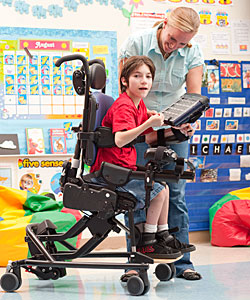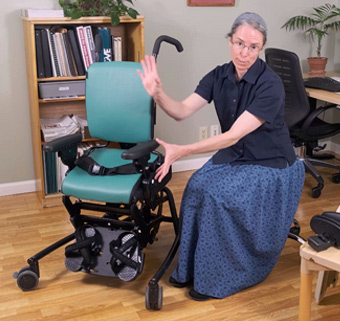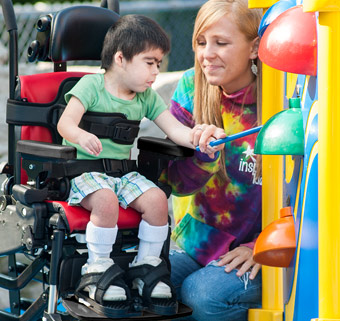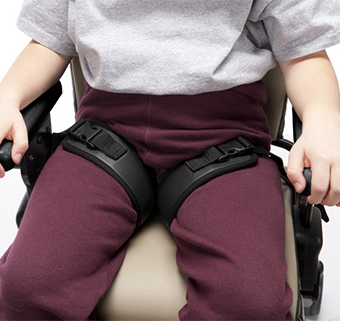Taking Advantage of the Dynamic Spring Options in the Rifton Activity Chair
| July 2013 My experience working with Rifton products spans 21 years but I had barely a clue about how the equipment was designed or fabricated until I visited Rifton’s Woodcrest and Platte Clove Communities in New York at the start of summer vacation. My visit to each community included a tour of the facility where the equipment is made and an opportunity to speak with some of the design team members. I saw meticulous attention to detail in all phases of production. I observed eyes and ears open to feedback and a willingness to know how the various products were impacting those who use them. There was clearly an attitude of dedication among the community members to develop new products and improve existing ones. I became involved in a discussion with the Platte Clove design team about the dynamic seat and backrest options on the Activity chair. They had received little feedback about these dynamic components and asked if I would share my observations with them and with you.
My experience working with Rifton products spans 21 years but I had barely a clue about how the equipment was designed or fabricated until I visited Rifton’s Woodcrest and Platte Clove Communities in New York at the start of summer vacation. My visit to each community included a tour of the facility where the equipment is made and an opportunity to speak with some of the design team members. I saw meticulous attention to detail in all phases of production. I observed eyes and ears open to feedback and a willingness to know how the various products were impacting those who use them. There was clearly an attitude of dedication among the community members to develop new products and improve existing ones. I became involved in a discussion with the Platte Clove design team about the dynamic seat and backrest options on the Activity chair. They had received little feedback about these dynamic components and asked if I would share my observations with them and with you.
The following case examples are of children I recently worked with in a classroom setting. I have given each child a fictitious name but all other information about each child is true. My intent is to provide a description of what I observed when each child was seated in a Rifton Activity Chair with dynamic componenets compared to a static seating system. None of these children received any physical therapy services outside of school. However, I cannot rule out the possibility of other influences that may have contributed to the improvements I noticed.
Case 1: Isabelle
Isabelle was 10 years old. She was diagnosed with cerebral palsy, seizure disorder, and a visual impairment. She often arched her body strongly into extension, pushing mostly with her head. Her extended head/neck position made it difficult to feed her. She was fully dependent for daily living activities and mobility. Isabelle’s former classroom seating system was an older model Rifton chair without a dynamic seat option. The chair had a curved headrest, lateral trunk supports, seatbelt, abductor, footboard, and tray. A commercially available chest harness was substituted for the chest strap because Isabelle’s upper trunk and shoulders moved forward and away from the seat back when she assumed her strong extensor posture. Isabelle would lift her hips off the seat when she arched and needed frequent repositioning and monitoring for pressure where the front of her pelvis pushed against the seatbelt. She did not tolerate any positioning devices on her feet or ankles and kept her legs in an extended position.
Isabelle was then seated in the newest version of the Rifton Activity Chair with a dynamic backrest on a hi-lo base. Initially, the positioning options on this chair included a curved headrest, lateral trunk supports, slim-cut butterfly harness, seatbelt, abductor, footboard, and tray. Isabelle smiled the first time she pushed into extension with her head and the backrest moved with her. Her tendency to arch continued, but after the first week, her extensor posturing was initiated more with her trunk than with her head. After using the new seating system approximately three months, she was able to rest her feet on the footboard loosely positioned with ankle straps, and keep her hips and thighs in contact with the seat when she pushed (with her trunk more than her head) into extension. There was less overall leg extension and adduction while sitting, and the hip abductor was removed from the chair. She was able to keep her head and trunk upright without the butterfly harness during most classroom activities. Feeding was easier because there was less arching of the head and neck.
Case 2: Molly
Molly was five years old, diagnosed with cerebral palsy, seizure disorder, and cortical blindness. She demonstrated minimal active movement of her arms, legs, and trunk, and was dependent for daily living activities and mobility. Molly had a static seating system with a headrest, lateral trunk supports, chest harness, seatbelt, and foot positioners, mounted on a wheelchair frame. She needed frequent repositioning and monitoring for skin breakdown because she moved so little on her own and had several areas of redness on her sacrum and buttocks.
Molly’s second classroom chair was the Rifton Activity chair with the dynamic backrest and dynamic seat on a standard base with casters. Positioning accessories included a curved headrest, lateral trunk supports, slim-cut butterfly harness, seatbelt, footboard, and ankle straps. When she was first introduced to this new chair only the seat spring was engaged, and she startled when she experienced the movement in the chair. By the end of the first day she was smiling when others rocked the chair for her. After two weeks both the dynamic seat and backrest components were engaged. Approximately one month later, Molly was starting to generate small movements of both thebackrest and seat using her head and trunk, and the chest harness was replaced with a chest strap to allow her to move more freely. After using the chair for approximately three months, she started using her hips and legs as well as her trunk and head to rock the chair. The rocking motion was gentle but she accomplished it without any help. The pressure areas that we’d been concerned about improved and no further areas developed.
Case 3: Lester
Lester was 17 years old and diagnosed with cerebral palsy . He sat with a posterior pelvic tilt and a rounded/kyphotic upper trunk posture. He liked movement and frequently rocked himself back and forth while he was seated. He assisted with some daily living skills and walked short distances with a walker. Lester’s former classroom chair was a static, commercially available chair with a seatbelt, chest strap, and armrests. He needed frequent verbal prompts to reposition his hips in this chair as he repeatedly slid forward on the seat. The more he slid forward, the more his upper trunk would round and collapse forward. As he grew taller and heavier, I became concerned that he would tip the chair when he rocked.
Lester’s next classroom chair was a Rifton Activity chair with the dynamic backrest and dynamic seat on a standard base with casters. Positioning accessories included a chest strap, seatbelt, and footboard. He initially rocked forcefully in the chair, but the chair was very stable and all casters stayed in contact with the floor. Throughout that first week he rocked himself whenever he was seated in the chair. There were periods of forceful rocking, but most of his movement became calmer. His hips did not slide forward on the seat as frequently as before, and his trunk was more active and erect, but still supported by the chest strap. After approximately one month, he was able to keep his hips properly seated in the chair and his torso upright without the chest strap until later in the afternoon when he became fatigued.
The positive outcomes I observed with these three students when the dynamic backrest and/or seat were used can be summarized as follows:
- Positive affect – smiling
- Decreased forceful head/neck extension
- Improved head posture for feeding
- Improved ability to maintain upright trunk position when sitting
- Decreased need for external positioning straps to support trunk
- Decreased lifting of pelvis and thighs off seat
- Decreased posterior tilt while sitting
- Decreased lower extremity extensor posturing when sitting
- Decreased hip adduction when sitting
- Improved position of feet/ankles when sitting
- Increased ability to generate active movement in trunk, hips, legs
- Improvement in pressure areas on sacrum, buttocks
These case examples may get you thinking about some of the Rifton products you use and the impact the various equipment has on your children and clientele. I encourage you to join me in sharing your thoughts and observations with Rifton.




